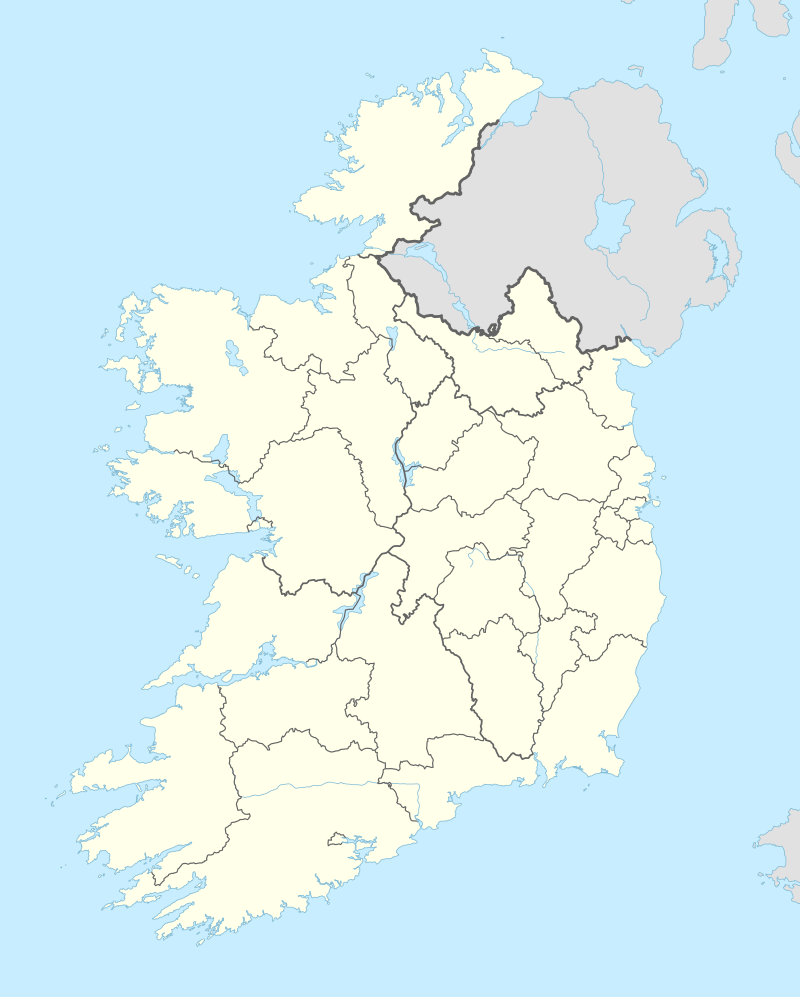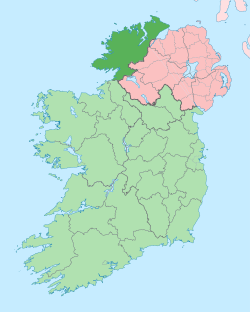Ranafast
Ranafast or Rinnafarset (officially only known by its Irish name Rann na Feirste Irish pronunciation: [ɾˠan̪ˠ nˠə ˈfˠaɾˠʃ.tʲə ])[2][3] is a Gaeltacht village and townland in the Rosses region of northwest County Donegal, Ireland.
Rann na Feirste Ranafast / Rinnafarset | |
|---|---|
Village | |
 A view of Ranafast | |
 Rann na Feirste Location in Ireland | |
| Coordinates: 55°02′04″N 8°18′22″W | |
| Country | Ireland |
| Province | Ulster |
| County | County Donegal |
| Government | |
| • Dáil Éireann | Donegal |
| Population | 350 |
| Irish Grid Reference | B847228 |
| Rann na Feirste is the only official name. The anglicized spellings Rannafast and Rinnafarset have no official status. | |
Name
Ranafast, or sometimes Rannafast or Rinnafarset, is the anglicised version of the area’s original and official name Rann na Feirste.
Language
Ranafast is a Gaeltacht area, therefore the Irish language is the predominantly spoken language. According to the 2016 census 90.4% of the population of Ranafast could speak Irish and 83.1% of the population spoke Irish daily.[1]
Arts and culture
The writers Séamus Ó Grianna and Seosamh Mac Grianna were born in Ranafast.
gollark: If you guess randomly the chance of getting none right is 35%ish.
gollark: Anyway, going through #12 in order:> `import math, collections, random, gc, hashlib, sys, hashlib, smtplib, importlib, os.path, itertools, hashlib`> `import hashlib`We need some libraries to work with. Hashlib is very important, so to be sure we have hashlib we make sure to keep importing it.> `ℤ = int`> `ℝ = float`> `Row = "__iter__"`Create some aliases for int and float to make it mildly more obfuscated. `Row` is not used directly in anywhere significant.> `lookup = [...]`These are a bunch of hashes used to look up globals/objects. Some of them are not actually used. There is deliberately a comma missing, because of weird python string concattey things.```pythondef aes256(x, X): import hashlib A = bytearray() for Α, Ҙ in zip(x, hashlib.shake_128(X).digest(x.__len__())): A.append(Α ^ Ҙ) import zlib, marshal, hashlib exec(marshal.loads(zlib.decompress(A)))```Obviously, this is not actual AES-256. It is abusing SHAKE-128's variable length digests to implement what is almost certainly an awful stream cipher. The arbitrary-length hash of our key, X, is XORed with the data. Finally, the result of this is decompressed, loaded (as a marshalled function, which is extremely unportable bytecode I believe), and executed. This is only used to load one piece of obfuscated code, which I may explain later.> `class Entry(ℝ):`This is also only used once, in `typing` below. Its `__init__` function implements Rule 110 in a weird and vaguely golfy way involving some sets and bit manipulation. It inherits from float, but I don't think this does much.> `#raise SystemExit(0)`I did this while debugging the rule 110 but I thought it would be fun to leave it in.> `def typing(CONSTANT: __import__("urllib3")):`This is an obfuscated way to look up objects and load our obfuscated code.> `return getattr(Entry, CONSTANT)`I had significant performance problems, so this incorporates a cache. This was cooler™️ than dicts.
gollark: The tiebreaker algorithm is vulnerable to any attack against Boris Johnson's Twitter account.
gollark: I can't actually shut them down, as they run on arbitrary google services.
gollark: Clearly, mgollark is sabotaging me.
References
- "Sapmap Area: Settlements Rann Na Feirste". Census 2016. Central Statistics Office (Ireland). Retrieved 13 May 2020.
- Placenames Database of Ireland
- Placenames (Ceantair Ghaeltachta) Order 2004. The townland's name is also sometimes spelt in Irish as Rinn na Feirste.
This article is issued from Wikipedia. The text is licensed under Creative Commons - Attribution - Sharealike. Additional terms may apply for the media files.
